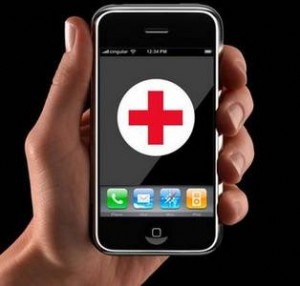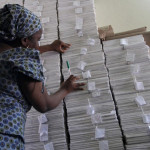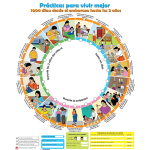Webinar Recap: Innovative Health Communication Apps
HC3’s ninth Innovation Webinar on June 9 provided attendees with introductions to four innovative health communication applications.
Session panelists included Edward Likovich, CEO of GoodLux Technology; Josh Nesbit, CEO of Medic Mobile; Michael Catalano, electric money ecosystem and mobile transactions specialist; and Dr. Ian Tong, Medical Director of Doctor on Demand. The webinar was moderated by Paige Dearing, Marketing and Communications Specialist at NetHope.
SunSprite: A Digital Health Engagement Solution for Depression Therapy
More than 350 people around the world suffer from depression. GoodLux CEO Ed Likovich and team have endeavored to help people take control of their lives with a simple, cost effective intervention: SunSprite.
Three in four people struggling with depression want to try something other than medication for treatment. SunSprite harnesses “bright light therapy,” a method proven to be as effective as other leading treatment methods – only working four times faster, and without the side effects – the simple solution of sunlight.
Patients are given a wearable device that measures the amount of light they’re receiving, and analyzes that light to manage energy, mood, and depression. Users access a complementary mobile app to track their progress towards the required dose of sunlight and determine whether the light is bright enough to be beneficial.
The app also houses decades of research around bright light therapy, presenting this information in a way that makes it easy to understand.
The GoodLux team has run seven successful pilots to date. Eighty-eight percent of patients have reported feeling better, and all 10 participating clinicians recommended the solution.
Medic Mobile: Communications Tools for Health Workers
Medic Mobile is a non-profit organization that builds mobile and web tools for health workers, clinics and families in remote communities. These tools are helping over 9,000 health workers provide care for five million people across sub-Saharan Africa, Asia and Latin America.
“The Medic platform has turned into a set of tools to support specific people in specific contexts across many different health systems,” said Josh Nesbit. “…A lot of our job is to support community health workers as local leaders.”
Priority use cases include the use of the Medic Mobile toolkit for antenatal care coordination, newborn health, disease surveillance and stock monitoring.
Nesbit also shared a few key learnings based on their experience over the past several years:
- In almost every village on the planet, there is a CHW or someone in a similar roll.
- Participatory design is critical.
- Products should be designed with and for the people.
- Use cases should have explicit impact logic.
By 2020, Medic Mobile hopes to connect and support as many as 200,000 health workers and provide better care for 100 million people.
Learn more about Medic Mobile’s approach.
WhatsApp: Enhancing Mobile Messaging in Emergency Response
The potential of social messaging to inspire behavior change communication is illustrated through the use WhatsApp during the 2014 Ebola outbreak as part of the Ebola Community Action Platform (E-CAP) solution in Liberia.
E-CAP was a social mobilization program funded by USAID and developed by Mercy Corps and Population Services International at the height of the emergency in 2014. The platform was made up of nearly 1,000 social mobilizers and a larger network of NGOs and communicators working to spread critical anti-Ebola messages throughout their communities.
Digital outreach focused on basic SMS for messaging, opinions polls, surveys and rapid research, and the collaboration team employed WhatsApp for enhanced mobile messaging applications and multi-media content distribution (such as audio, photos and video). ICT and content development partners included HC3, NetHope, UNICEF and Johns Hopkins CCP.
More than 80% of mobilizers participated on the SMS channel (provided by UNICEF), while 30% participated on WhatsApp – but those who did made very effective use of it.
“WhatsApp was used primarily to see how far we could extend ubiquitous mobile messaging (SMS), which didn’t have the capability to distribute and receive digital content,” said Mike Catalano, electric money ecosystem and mobile transactions specialist.
Catalano shared several considerations for others when deciding which mobile messaging channel to use:
- Assess whether the use of the mobile communication channel can influence the behavior change communication desired.
- Determine whether or not the channel provides a relevant feedback loop to the social mobilizers, and whether or not those mobilizers are using it effectively to provide feedback to program managers.
- Understand whether or not the channel works in tandem with digital content that’s being prepared or that will be available during the program execution. (And how often there will be a refresh of content.)
- Determine the state of connectivity.
Learn more about E-CAP’s digital outreach.
Doctor on Demand: Connecting Patients with Physicians
Dr. Ian Tong and team are working to improve access to health care with the development of a first-of-its-kind digital health solution: Doctor on Demand (DOD).
DOD allows patients to connect with physicians, psychologists and lactation consultations with real time audio and video (on demand or by appointment).
To access the service, patients download the application to a tablet, smartphone or computer and must have 4G LTE or high-speed Internet.
One-on-one consultations with licensed physicians start at $40 for 15 uninterrupted minutes. The video-based platform supports telemedicine exam techniques including visual face-to-face, peripheral devices, physician directed exams, high-resolution images, medication history via the SureScripts eRX network, and medical/lab record sharing.
Dr. Tong and team have built the “minimal viable product” and are waiting to add certain features like SSN, insurance, and employer identification.
“When you enter into a market, the market already has players. When you’re building a disruptive technology, you need to be aware of the balance or nuance of being disruptive and make something better while having some amount of respect for the system that’s in place,” said Dr. Tong.
He also emphasized the importance of patient service. After each visit, patients can rate doctors and give feedback. The average DOD post-consulting rate is 4.8 (out of 5), and the app is currently ranked #1 in the Medical category on iTunes and Google Play.
Dr. Tong had a few bits of advice to offer for others interested in the development of innovative health apps:
- Unlearn what you already “know about how it works” – maximize iterative cycles.
- Simplicity is key.
- Justify each product before building it.
- And again, customer service, customer service, customer service. It’s all about customer service.
Learn more about Doctor On Demand.
Download the Presentations and Listen to the Recording
This webinar is the latest in an ongoing series produced over the past year and a half by the Health Communication Capacity Collaborative (HC3), a five-year global project funded by USAID and led by CCP in partnership with Management Sciences for Health, NetHope, Population Services International, Ogilvy Public Relations, Internews and Forum One Communications. HC3’s main objective is to strengthen capacity to design, implement and evaluate state of the art social and behavior change communication programs. The Innovation Webinar Series works to help achieve this objective by spotlighting a broad range of health communication innovations and engaging a diverse audience around a meaningful mix of theory and practical examples, drawn from academic, public and private sectors.








Leave a Reply
Want to join the discussion?Feel free to contribute!